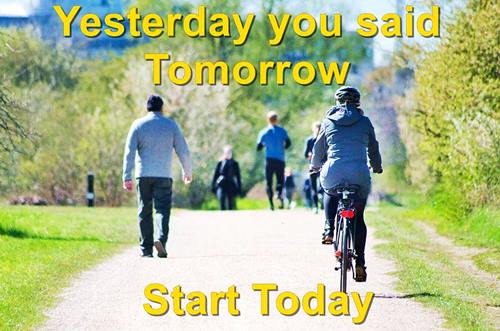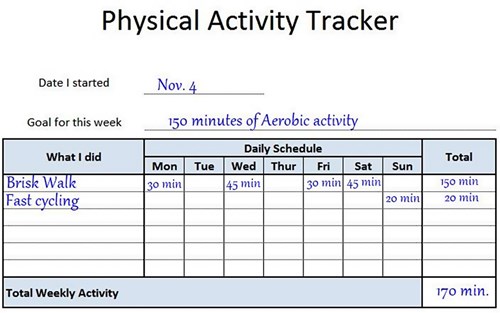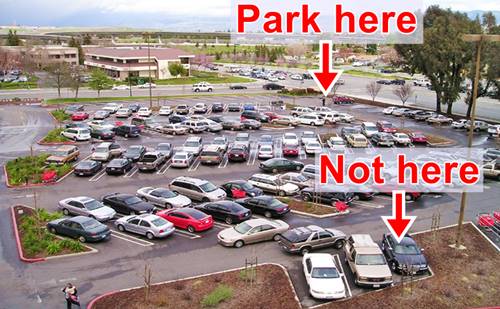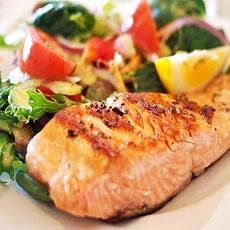How to get started with your exercise program
8 Steps to start your Fitness program
Fact Checked
×All the content published in our website is fact checked to validate its accuracy.
Visit our guidelines web page to learn more about our strict processes regarding how we review our content's sources: reliable and reputable journals, media websites, universities, colleges, organizations, and professionals.
Our articles are based on scientific evidence, and the references are included in its footnotes, which are clickable links to sound scientific papers.
First published: 15.Nov.2018
Overview: Get started and stay motivated with your Fitness Program
Physical activity and regular exercise are the keys to maintaining your overall health and fitness. Not only will it help you lose weight and keep it off, but it will also reduce your health risk.
In this article, we will explain how to get started. We will also provide tips on how to stick to your exercise plan and not give up.
Starting an exercise program is a very important decision, and it is easier than it seems. Plan it carefully and go ahead step by step building a healthy habit that will make you feel much better.
In this Article (Index)
- First Steps towards Fitness: Design your Exercise Program and see it through
- Define your Goals
- Physical Activity Guidelines
- Pick an activity
- Set yourself SMART Goals
- Keep Track of your progress
- Start Slowly and Build up over time
- Build-in motivation
- Avoid the excuses and pitfalls
- Stay Safe and avoid injuries
- Review your Progress

First Steps towards Fitness: Design your Exercise Program and see it through
So you have made up your mind, you want to feel fitter, perhaps lose some weight, shape up, feel more energetic, vital. Congratulations, this is one of the best decisions you have ever taken in your whole life!
Now you have to put it into practice.
These tips and advice will help you do precisely that. These are Eight Tips to get started with your fitness and exercise program:
1. Define your Goals
First of all, you need clear goals. Why are you starting on a fitness program? To train for some event? Lose weight? or simply feel fitter and more flexible?
Knowing your reasons for exercising will help you define your program.
How much do you need to exercise? The US Department of Health and Human Services has published some recommended guidelines that can help you prepare your custom fitness program:
Physical Activity Guidelines
The Physical Activity Guidelines for Americans (1) defined by the U.S. Department of Health and Human Services lays down the recommended amount and type of physical activity needed to maintain health.
Adults 18 to 64 years old
- Any physical activity (PA) is better than none. Avoid inactivity. Any amount of PA will provide health benefits.
- For "substantial" health benefits: Do at least 150 minutes per week (2 hours and 30 minutes) of moderate-intensity activity or 75 minutes (1 hour and 15 minutes) of vigorous-intensity aerobic physical activity each week. Or a combination of both.
- Aerobic activity should last at least 10 minutes and be spread out throughout the week.
- For even more health benefits increase the moderate-intensity aerobic activity to 5 hours⁄week or the vigorous-intensity to 150minutes ⁄week.
- You should also include muscle-strengthening activities involving all major muscle groups on 2 or more days a week.
Older Adults: above 65 years
- Try to follow the adult guidelines above, if you can't then try to keep as physically active as possible.
- Exercise to maintain and improve balance -to avoid the risk of falling.
- Your level of physical activity (PA) should be in line with your level of fitness.
- Those suffering from chronic health conditions should understand whether and how their conditions affect their ability to do regular PA safely.
Some definitions of intensity
- Moderate-intensity physical activity is an aerobic activity that increases your heart rate and breathing somewhat. So it is a 5 or 6 on a 0 to 10 scale.
Examples: Brisk walking, swimming, cycling on level terrain, or dancing. You can maintain a conversation during moderate PA. - Vigorous-intensity physical activity is an aerobic activity that greatly increases your heart rate and breathing. It is a 7 or 8 on a 0 to 10 scale.
Examples: singles tennis, cycling uphill, jogging, swimming continuous laps. You will find it hard to keep up a conversation. - Muscle-strengthening activity is a physical activity that builds muscle power, mass, and endurance. It includes strength training, resistance training, muscular strength, and endurance exercises.
2. Pick an activity
You can be physically active in many ways, you can walk, cycle, jog, run, train, and work out, dance, play tennis, etc.
You should write down a list of all the activities that you would like to do, even if you've never done it before (for instance kickboxing, or body-pump). Then focus on those that you enjoy (it will help you stick to your program). An activity that matches your ability is a good option.
3. Set yourself SMART Goals
A goal like "I'm going to be more active this week" won't cut it. Too vague and weak, it won't motivate you at all.
Goals should be SMART. SMART is an acronym for Specific, Measurable, Achievable, Relevant, and Time phased.
Setting SMART goals defines them and makes it easier to accomplish them. So instead of "vague" objectives (Walk at a brisk pace, for instance), set specific ones that can be measured ("walk for half an hour") and feasible ("In the evening, after work"), and time-phased so that each daily goal will help you achieve your weekly goal ("five days a week").
Keep Track of your progress
The following chart can help you write down your weekly goals and keep track of your daily and weekly progress. (Download chart here).
You can use one chart to track aerobic activities (jogging, walking, or cycling) and another for muscle-strengthening activities.

At this point, you have your goals, your plan, and a tracking chart. It is time to start training.
4. Start Slowly and Build up over time
You have to get into shape and avoid injuries, if you overdo it at first, you will hurt your joints or muscles (read more below on how to exercise safely). Give yourself time to rest and recover between sessions.
Read this before you start
Before participating in any diet or exercise program or using any diet or fitness products or services that may be described on or through Fit-and-Well.com, we strongly recommend that you consult with a physician or other healthcare provider.
Our Fitness and Wellness Content should not be used instead of professional advice given by qualified medical professionals such as your doctor or registered dietitian, or other Professional Care Provider.
Our Fitness and Wellness Content should only be used under qualified medical guidance. If you know or suspect that you may be pregnant, have an eating disorder, have diabetes, or have any other physical, psychological, emotional, or medical condition, seek the immediate advice of your doctor or before using our Fitness or Wellness Content.
Should you experience any discomfort or pain during an activity suggested in our Fitness or Wellness Content: such as a diet or an exercise routine, you must immediately cease the activity and seek the assistance of a physician or other applicable Professional Care Provider.
Point to remember:
Some activity is better than none and, the more you do the better you'll feel.
Becoming Fitter is a Gradual Process
Start slowly, cautiously, and build up from there by adding more activity.
Your goal for the first week, if you are very sedentary could be walking at a moderate pace over three days for 20 minutes each day. This is far from the recommended 150 weekly minutes of moderate activity, but it is a step in the right direction.
As you feel fitter, you can lengthen your activity and do them more frequently and with more intensity: walk for 30 minutes four times a week (on Week #2), and then 5 times a week on Week #3. Finally, on Week #4 you can walk five times and extend your walks to 45 minutes at a brisk pace.
If you already walk, consider adding cycling to your weekly routine.
Adding more activity to your program
Gardening, dancing, push-ups, sit-ups, squats... and also include more activity at work (go up the stairs instead of taking the elevator, park further away in the parking lot so you will walk more).

Look after yourself: Use the right footwear
Use light running shoes when you walk, they will give you better support. Wear light clothes in hot weather, download a step-counting or distance-measuring app for your smartphone to help you keep track of your progress.
5. Build-in motivation
Sometimes it is easy to feel discouraged, tired, and lose motivation. Learn how to keep motivated and stick to your daily exercise program.
Tips for sticking with your fitness plan
- Include activities that you will enjoy, are affordable, safe, and that you can do, and fit into your daily schedule (trekking in the woods may sound great, but may not be feasible if you live 30 miles from the nearest trail).
- Imagine how much you and your health will benefit from your regular exercise program: chart your weight loss or improving stamina.
- Reward yourself for meeting your goals. Not with food though! Try a new healthy recipe or buy yourself those new running shoes you saw online.
- Try exercising with a friend or walking with your spouse -or dog, Fido will want to take his walk every day and prompt you to do so too. You will be adding quality time together with the bonus of getting even fitter.
- Share your goals with friends and family, and let them know what changes you are trying to make, ask them to tell you if they see you falter. Their support and encouragement will help you stick to the plan.
- Have a "Plan B" for bad weather, injury, illness, or other unexpected events. Regroup and start again as soon as possible.
Know WHY you are getting into shape
Educate yourself, learn about the health benefits of being fit, losing weight, building muscle. Read articles -visit websites like ours on the Internet- learn more: new healthy recipes, training tips, or activities.
Keep Inspired. Feel how your mood, vitality, and sleep quality improve with exercise, notice how you feel stronger, leaner, and lose weight. The benefits of exercising are great and attaining them depends only on your motivation and willpower.
6. Avoid the excuses and pitfalls
Don't let the same old excuses hold you back:
- It has been a long time since I exercised. Chose something easy to start with, something you like doing. Walking is simple and easy.
- I don't have the time. You can build in 10-minutes of physical activity in sessions throughout the day. A short walk before breakfast, after your lunch break, walk up a flight of stairs, walk your kids to school, take a break from the TV or your work desk, stand up, stretch, take a short stroll.
- It costs too much. Get fit for free. You don't have to join a gym or a health club, or spending lots of cash on gear. Use what you have, for free. Walk, cycle, jog, or do gardening.
- It's too hot, too cold, rainy, etc. Use the right gear to protect yourself from the weather, and keep on training. Go indoors in foul weather (how about your local place of worship or community center? or even the local shopping mall -ideal for walking in any kind of weather).
Don't procrastinate, or look for excuses. The Centers for Disease Control (CDC) has some tips for Overcoming Obstacles to Physical Activity.
7. Stay Safe and avoid injuries
If you have a health condition or are pregnant, make sure you visit your health care provider before starting any physical activity or training program.
Don't overdo it, build up gradually if you have been inactive for some time.
The type of activity and the amount and intensity must be appropriate for your fitness level.
Warm-up with some low-intensity activity before starting your daily exercise session.
See this Warm Up Routine
See this short warming up routine to avoid injury.
Keep hydrated. Drink water before, during, and after your training session.
Learn the risks of dehydration
> > Dehydration and how to prevent it
Wear the right clothes, they should be comfortable and fit loosely so as not to hamper your movements.
Listen to your body: If you feel unwell (chest, arm, neck shoulder pain), cramps, pain in your joints or feel dizzy. Stop exercising immediately.
Keep visible and pay attention to traffic and walking surfaces if walking or cycling outdoors.
8. Review your Progress
As you become fitter and stronger you can review your goals and make them more challenging, set new ones, try other activities. Plan a canoe trip for next summer or that trek along the Appalachian Trail that you've always dreamed about. And train for it.
Habits take time to consolidate, but with support, inspiration, and education you can quit the bad ones and incorporate new ones.
Probably you'd like to join a group or a class or improve some techniques, join a health club or your local running club. The opportunities for increasing your physical activity and enjoying the process are almost endless. It depends on you.
Summing it all up
In a paper on exercise and its health benefits, James A. Blumenthal, Patrick J. Smith, and Benson M. Hoffman, (2012) (2) gave these Seven Tips for Highly Effective Exercisers, that summarize what we have written above, we quote them below:
James A. Blumenthal, Patrick J. Smith, and Benson M. Hoffman, (2012) (2)
- Just do it. Choose an activity that you enjoy-and stick with it. Just because you "don't feel like it" is not a reason not to exercise. Tell yourself that you'll feel better afterwards.
- Don't neglect your feet. Invest in a good pair of exercise sneakers. It's an investment that you won't regret!
- Timing is everything. Exercise at a time of day that is most convenient. Do not exercise on a full or empty stomach or just before you go to bed. People with depression often suffer from insomnia, and night time exercise can leave you feeling energized when you want to sleep. If possible, exercise during daylight hours to also benefit from sunlight.
- Watch out for barriers. Anticipate barriers to exercise, and develop strategies to make exercise as easy and simple as possible. Anticipate barriers-bad weather, work commitments, fatigue, and brainstorm potential solutions.
- Get a buddy. Some people who exercise with a partner enjoy it more and are more likely to stick with it. Also, the additional social support may have additional beneficial effects.
- Think positive. Praise your successes. View lapses in your exercise program as learning opportunities and don't get discouraged if you miss a session.
- Enjoy.
References and Further Reading
(1) Dietary Guidelines 2015-2020 - Appendix 1. Physical Activity Guidelines for Americans. Accessed 04 Oct 2023.
(2) James A. Blumenthal, Patrick J. Smith, and Benson M. Hoffman, (2012). Is Exercise a Viable Treatment for Depression?, ACSMs Health Fit J. 2012 July/August; 16(4): 14-21. doi: [10.1249/01.FIT.0000416000.09526.eb]
National Institute of Diabetes and Digestive and Kidney Diseases, Tips to Help You Get Active. Accessed Nov. 22, 2020
ODPHP Publication, Physical Activity Guidelines for Americans 2nd edition. Accessed Nov. 22, 2018
NIH MedlinePlus, US National Library of Medicine, Exercise and Physical Fitness, page last updated on 16 October 2020. Accessed Nov. 22, 2020.
CDC Getting Started with Physical Activity for a Healthy Weight. Accessed Nov 22, 2020.
About this Article
How to get started with your exercise program, A. Whittall
©2023 Fit-and-Well.com, 08 Oct. 2023. Update scheduled for 08 Oct. 2025. https://www.fit-and-well.com/fitness/get-started.html
Tags: exercise, weight loss, fitness


